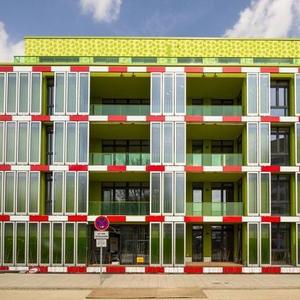World's first algae house produces green energy at IBA Hamburg



Photo: Johannes Arlt, IBA Hamburg GmbH
May 2, 2013
BY Hamburg Business Development Corp.
The first house in the world to supply its own energy with unique “bioskin” through the cultivation of micro-algae is being presented at the International Building Exhibition IBA Hamburg in Germany.
As a part of the International Building Exhibition IBA Hamburg, the Bio Intelligent Quotient (BIQ) House is the world’s first building to have a bioreactor façade. The façade of the five-story BIQ House comprises a vertical algae farm with an integrated bioreactor, turning the building into a Plus Energy House. This weekend, the house became fully operational as the glass façade was filled with liquid biomass. From now on, microalgae will be cultivated in 129 transparent glass panels, individually measuring 2.5 x 0.7 meters, which make up its “bioskin.” While these panels are used to produce energy, they also regulate light and provide shade. The combination of energy-saving algae and geothermal and solar energy will generate more energy than the residents of the house will consume.
“The BIQ House makes the district of Wilhelmsburg, the biggest urban river island in the heart of Hamburg, more sustainable,” said Uli Hellweg, managing director of the IBA. “From now on, the microalgae on the façade will be supplying renewable energy for the building’s residents and the surrounding district. We know that about one-third of CO2 emissions are produced by households. Because of that, this innovative approach of sustainable urban living is an important signal for building construction in times of climate change. The BIQ House is part of a cluster of different energy projects launched by the IBA that will help to make Wilhelmsburg the most climate-friendly district in Hamburg within this year. Within the next four decades, the district of Wilhelmsburg with more than 50,000 inhabitants could become completely carbon-neutral.”
Cycles of Solar Energy
Advertisement
With its holistic energy concept, the BIQ building is setting new standards: it draws all of the energy needed to generate electricity and heat from renewable sources—fossil fuels are not required. The building is able to generate energy using the algae biomass harvested from its own façade. Moreover, the façade collects energy by absorbing the light that is not used by the algae and heat generation, similar to a solar thermal unit, and is then either used directly for hot water and heating, or can be cached for later use in the ground using borehole heat exchangers—80 meter-deep holes filled with brine. This remarkably sustainable energy concept is thus capable of creating a cycle of solar and geothermal energy, while also integrating a condensing boiler, local heat and the capture of biomass using the bioreactor façade.
Multifunctional Façades
The BIQ building shows that, in future, façades will be able to serve a number of different functions, and be much more than an aesthetic cladding to protect against the elements. While the northeast and northwest sides of the building have an elaborately decorated shell to draw the eye, the algae within the southwest and southeast façades produce biomass for renewable energy. In addition, the façade also serves the more conventional purposes of insulating the building from sound, heat and cold, and provides shade in bright sunlight. But the house will also offer residents a new approach to life using visionary spatial concepts. Individually controlled rooms will make it possible to switch functions and components on and off on demand.
Advertisement
IBA: Models for Climate-Friendly Urban Development
On Europe’s biggest urban river islands, Wilhelmsburg and Veddel, the International Building Exhibition IBA Hamburg is currently showcasing future modes of living, working and learning. In 2013, the IBA’s presentation year, more than 60 projects are displaying innovative approaches for the city of the future. Additional topics include ideas for future energy supply and ways of addressing the challenges posed by climate change. Right beside the new Inselpark, on the international garden show premises, the “Building Exhibition within the Building Exhibition” opened its gates on March 23. This key IBA project in Wilhelmsburg Central showcases the future of building and living, with smart buildings constructed of “intelligent” and regenerative building materials—such as the BIQ House with its energy-supplying algae façade or the Energy Bunker, a former flak bunker, now a flagship for renewable energy.
Hamburg: Hotspot for Green Techs, Renewable Energies
Hamburg is combining environmental protection with economic growth. Projects such as the International Building Exhibition IBA Hamburg exhibit the potential of green technologies for companies and residents alike. Hamburg has the potential to successfully implement the energy transition, meet ambitious climate targets and create additional jobs. This is also owing to the strength of the city’s companies and research facilities in the field of green technology. According to a 2012 survey of the Hamburg Chamber of Commerce and Industry, there are approximately 1,980 green technology companies in Hamburg with around 33,400 employees. These companies are active in the core fields of power generation, green building, water, recycling and waste management, financing and insurance, energy services, as well as mobility and logistics. The estimated sales volume for 2012 amounted to approximately €10.66 billion.
Related Stories
The USDA significantly increased its estimate for 2025-’26 soybean oil use in biofuel production in its latest World Agricultural Supply and Demand Estimates report, released July 11. The outlook for soybean production was revised down.
U.S. fuel ethanol capacity fell slightly in April, while biodiesel and renewable diesel capacity held steady, according to data released by the U.S. EIA on June 30. Feedstock consumption was down when compared to the previous month.
The U.S. EPA on July 8 hosted virtual public hearing to gather input on the agency’s recently released proposed rule to set 2026 and 2027 RFS RVOs. Members of the biofuel industry were among those to offer testimony during the event.
The USDA’s Risk Management Agency is implementing multiple changes to the Camelina pilot insurance program for the 2026 and succeeding crop years. The changes will expand coverage options and provide greater flexibility for producers.
The USDA’s National Agricultural Statistics Service on June 30 released its annual Acreage report, estimating that 83.4 million acres of soybeans have been planted in the U.S. this year, down 4% when compared to 2024.
Upcoming Events










